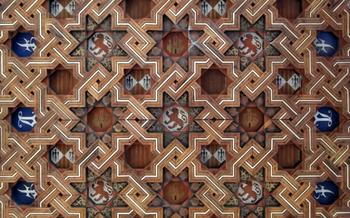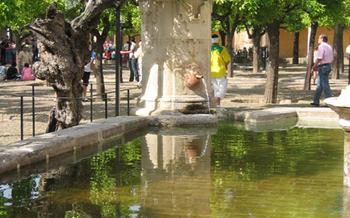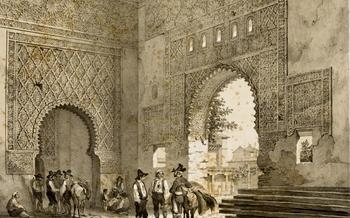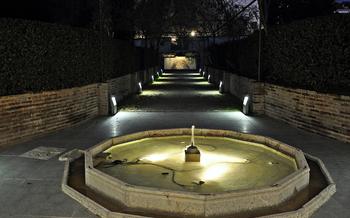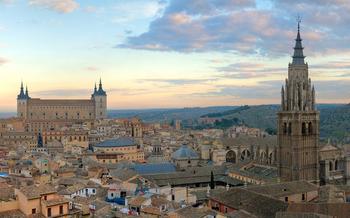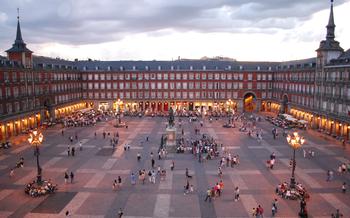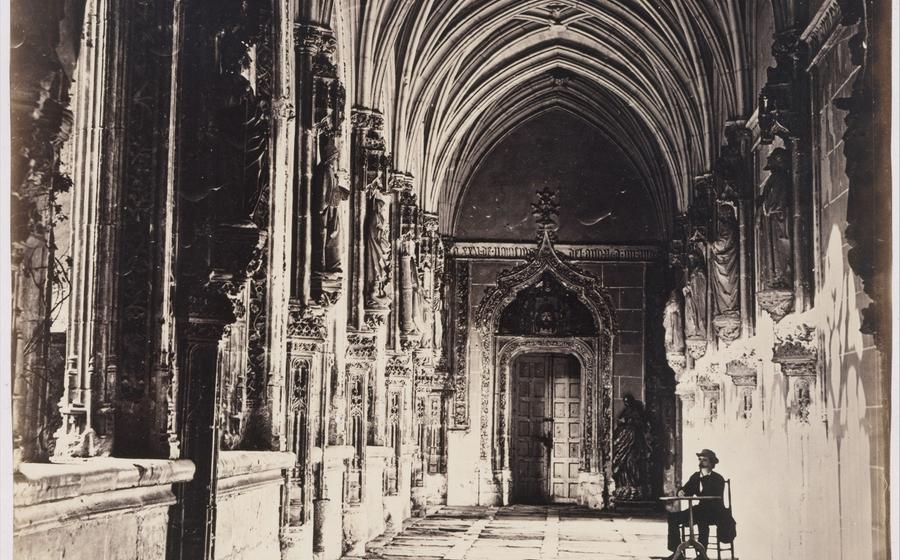
The Monastery of Saint John of the Kings
- The Monastery of Saint John of the Kings: A Gothic Masterpiece
- History and Background:
- Architectural Highlights:
- Location and Accessibility:
- Exploring the Interior: A Journey Through Time
- A Symbol of Royal Patronage: The Royal Tombs
- The Legend of Queen Isabella's Miracle
- The Gothic Architecture: A Symphony of Stone
- The Intricate Details: A Feast for the Eyes
- A Place of Worship and Serenity: The Church
- The Cloister: A Haven of Tranquility
- The Royal Chapel: A Testament to Majesty
- The Museo de Santa Cruz: A Treasure Trove of Art
- The Surrounding Area: Exploring Toledo's Charm
- Planning Your Visit: Practical Tips
- Photography Tips: Capturing the Monastery's Beauty
- Respecting the Sacred Space: Monastery Etiquette
- Insider Tip: Discovering Hidden Gems
The Monastery of Saint John of the Kings: A Gothic Masterpiece
In the heart of Toledo, a city steeped in history and cultural treasures, stands the Monastery of Saint John of the Kings, a remarkable monument to Gothic architecture and royal patronage. Founded in 1477 by the Catholic Monarchs, Ferdinand and Isabella, this monastery is a testament to their devotion and the power of their reign.
History and Background:
The Monastery of Saint John of the Kings was built on the site of a former synagogue, a symbol of the religious transformation that swept through Spain during the Reconquista. The Catholic Monarchs sought to establish a lasting legacy of their reign, and the monastery served as a symbol of their piety and their commitment to the unification of Spain under Christian rule.
Architectural Highlights:
The monastery is a masterpiece of Gothic architecture, showcasing the intricate details and soaring heights that define the style. Its stunning facade, adorned with delicate carvings and intricate tracery, hints at the splendor that awaits within. The interior of the monastery is equally impressive, with its elegant cloisters, vaulted ceilings, and exquisite stained glass windows.
Location and Accessibility:
The Monastery of Saint John of the Kings is strategically situated in the historic center of Toledo, a city known for its rich cultural heritage and medieval charm. It is easily accessible on foot or by public transportation, making it a convenient destination for visitors exploring the city's many attractions.
Exploring the Interior: A Journey Through Time
Venturing into the Monastery of Saint John of the Kings is like stepping back in time and immersing oneself in the grandeur of the Gothic era. The interior of the monastery is a testament to the artistry and devotion of its builders, boasting awe-inspiring architectural features that captivate the senses.
The Main Altar:
As you enter the church, your gaze is immediately drawn to the magnificent main altar, a masterpiece of Gothic craftsmanship. Intricate carvings adorn the altar, depicting scenes from the life of Christ and the saints, while the vibrant colors of the stained glass windows cast a warm glow upon the sacred space.
The Cloister:
Beyond the church lies the serene cloister, a tranquil haven that invites contemplation and reflection. The Gothic arches and delicate tracery create a sense of lightness and airiness, while the lush gardens and central fountain add a touch of tranquility to the surroundings.
The Royal Chapel:
The Royal Chapel, located off the cloister, is a testament to the monastery's royal patronage. This opulent chapel is adorned with exquisite decorations, including intricate carvings, stunning frescoes, and a magnificent altarpiece. The tombs of several Spanish monarchs, including Henry IV and Isabella I, add to the chapel's regal atmosphere.
A Symbol of Royal Patronage: The Royal Tombs
Toledo's history is closely entwined with the Spanish monarchy, and the Monastery of Saint John of the Kings proudly displays this connection through its impressive collection of royal tombs. These tombs, commissioned by various monarchs, serve as magnificent testaments to their power, piety, and artistic patronage.
History of the Royal Burials: The tradition of royal burials at the monastery began in the 15th century when King Henry IV ordered the construction of his tomb within the church. This marked a significant departure from the customary burial practices of Spanish royalty, who were traditionally interred in the royal pantheon of the Cathedral of Toledo. Henry IV's decision to be buried at the monastery reflected his deep devotion to the Dominican Order and his desire to be associated with the sacred space.
Significance of the Tombs: The royal tombs at the Monastery of Saint John of the Kings hold immense historical and artistic importance. They represent the convergence of royal patronage, religious devotion, and artistic expression. The elaborate designs, intricate carvings, and stunning effigies adorning the tombs showcase the exceptional craftsmanship and artistic talent of the era.
The Tombs of Henry IV and Isabella I: Among the most notable royal tombs is that of King Henry IV, which features a magnificent alabaster effigy of the monarch. The tomb also boasts intricate carvings depicting scenes from his life and reign. The tomb of Queen Isabella I, located in the Royal Chapel, is another masterpiece of funerary art. It features a beautiful effigy of the queen, surrounded by delicate carvings and adorned with gold leaf.
The Legend of Queen Isabella's Miracle
Amidst the grandeur of the Monastery of Saint John of the Kings, a captivating legend unfolds, intertwining history and faith. It is said that Queen Isabella I of Castile, renowned for her devotion and determination, once found herself in a desperate situation during the Siege of Granada in 149As the battle raged on, the queen made a solemn vow to Saint John the Baptist, the monastery's patron saint. She promised that if the Christian forces emerged victorious, she would erect a grand and magnificent monastery in his honor.
In a testament to her unwavering faith, the Christian forces prevailed, and the Reconquista was finally completed. True to her word, Queen Isabella initiated the construction of the Monastery of Saint John of the Kings, a splendid edifice that stands as a symbol of her gratitude and devotion. The monastery's intricate carvings and opulent decorations are a reflection of the queen's deep faith and the miraculous victory that it commemorates.
The legend of Queen Isabella's miracle has become an integral part of the monastery's history, adding a layer of enchantment to this already extraordinary site. Visitors to the monastery can still marvel at the stunning architecture and artwork, all of which bear witness to the queen's unwavering faith and the miraculous events that unfolded during the Siege of Granada.
The Gothic Architecture: A Symphony of Stone
The Monastery of Saint John of the Kings is a prime example of the Gothic architectural style that dominated Europe during the Middle Ages. Its construction began in the 15th century, and it showcases the intricate details and soaring heights that characterized Gothic architecture.
The exterior of the monastery features flying buttresses, which are arched supports that help to distribute the weight of the walls and allow for larger windows. These buttresses are adorned with intricate carvings and pinnacles, creating a sense of visual interest and lightness.
The interior of the monastery is equally impressive, with its vaulted ceilings and ribbed arches creating a sense of awe and wonder. The nave, or central aisle of the church, is lined with slender columns that support the weight of the ceiling. These columns are adorned with intricate carvings, and the capitals at the top of the columns feature a variety of motifs, including human figures, animals, and plants.
The Gothic style of the monastery is also evident in its use of stained glass windows. The windows depict scenes from the Bible and the lives of the saints, and they fill the interior with vibrant colors and light. The windows also serve to tell stories and teach lessons, and they were an important part of the educational and devotional practices of the medieval period.
The Intricate Details: A Feast for the Eyes
The Monastery of Saint John of the Kings is a veritable treasure trove of intricate details that captivate the eye and inspire awe. The elaborate carvings adorning the walls, ceilings, and pillars showcase the exceptional craftsmanship and artistry of the Gothic era. Each intricate design, whether a floral motif, a biblical scene, or a mythical creature, seems to come alive, adding depth and dimension to the monastery's interior.
The stunning stained-glass windows, with their vibrant hues and intricate patterns, bathe the interior in a kaleidoscope of colors, creating an ethereal and almost magical atmosphere. The windows depict scenes from the Bible, the lives of saints, and historical events, offering a visual narrative that transports visitors back in time.
The rich symbolism and iconography found throughout the monastery add layers of meaning to the architectural masterpiece. From the intricate carvings of animals, representing various virtues and vices, to the symbolic use of light and darkness, the monastery's every detail seems to hold a deeper significance, inviting visitors to contemplate and unravel its hidden messages.
A Place of Worship and Serenity: The Church
A prominent feature of the Monastery of Saint John of the Kings is its breathtaking church, a testament to the Gothic style's grandeur and religious significance. The church's history is intertwined with the monastery's founding, serving as a spiritual center for the Franciscan friars and a place of worship for the surrounding community.
The church's altarpiece, a masterpiece of intricate carvings and gilded details, is a focal point of the interior. It depicts scenes from the life of Jesus Christ and the Virgin Mary, capturing the essence of the Catholic faith. The vibrant colors and expressive figures bring the biblical narratives to life, creating an awe-inspiring ambiance that invites contemplation and devotion.
Beyond its aesthetic beauty, the church exudes a palpable sense of serenity and spirituality. The soft light filtering through the stained glass windows casts a warm glow, illuminating the sacred space and creating an atmosphere conducive to prayer and reflection. The harmonious blend of architectural elements, from the vaulted ceilings to the graceful arches, fosters a sense of tranquility and communion with the divine.
The Cloister: A Haven of Tranquility
Amidst the grandeur of the Monastery of Saint John of the Kings, the cloister stands as an oasis of serenity, inviting visitors to find solace and contemplation. Step through the arched entrance and be greeted by a tranquil courtyard, adorned with lush gardens and a central fountain. The soothing sound of water trickling creates a calming atmosphere, while the fragrant scent of flowers fills the air.
The cloister's graceful arches and intricate carvings provide a picturesque backdrop for quiet reflection. Take a moment to wander along the covered walkways, admiring the intricate details adorning the columns and capitals. Each archway frames a different perspective of the courtyard, offering a constantly changing view.
As you stroll through the cloister, let your mind wander back in time, imagining the monks who once walked these same paths, seeking peace and spiritual fulfillment. The cloister was a place of retreat and study, where the monks could escape the distractions of the outside world and focus on their devotion.
In the center of the courtyard, a beautiful fountain symbolizes the purity and abundance of life. Water, a vital element in this arid region, is a reminder of the monastery's connection to the natural world. The fountain's gentle flow creates a soothing melody, adding to the tranquil ambiance of the cloister.
The Royal Chapel: A Testament to Majesty
The Royal Chapel, located within the Monastery of Saint John of the Kings, stands as a testament to the grandeur of the Spanish monarchy. Constructed under the patronage of Queen Isabella I and King Ferdinand II, it served as a private sanctuary for the royal family. The chapel's exquisite decorations and artwork reflect the artistic prowess of the era, showcasing the finest craftsmanship and materials.
The intricate carvings that adorn the chapel's walls and ceiling depict scenes from the Bible and the lives of saints, creating a visually captivating narrative. The stunning stained glass windows, with their vibrant colors and intricate designs, bathe the interior in a warm, ethereal light, adding to the chapel's sacred atmosphere.
The chapel's most notable feature is the magnificent altarpiece, a masterpiece of Gothic art. Carved from alabaster, the altarpiece depicts scenes from the life of Christ and the Virgin Mary, with intricate details and lifelike expressions that captivate the viewer's attention. The altar is adorned with gold leaf and precious stones, further enhancing its grandeur and opulence.
The Royal Chapel served as the setting for significant royal events, including weddings, baptisms, and coronations. It was here that Queen Isabella and King Ferdinand were interred after their deaths, their tombs becoming a symbol of their enduring legacy. The chapel's regal atmosphere and rich history make it a must-see attraction for anyone interested in Spanish history, art, and architecture.
The Museo de Santa Cruz: A Treasure Trove of Art
The Monastery of Saint John of the Kings is home to the Museo de Santa Cruz, a captivating museum that houses an extensive collection of religious art and artifacts. Established in the 19th century, the museum occupies the former Hospital of Santa Cruz, which was founded by Cardinal Mendoza in the 15th century.
The museum's collection showcases a diverse range of artistic styles and periods, from the Middle Ages to the Renaissance and beyond. Visitors can admire exquisite paintings, sculptures, tapestries, and other works of art that provide a glimpse into the rich artistic heritage of Spain. Among the highlights of the collection are El Greco's "The Burial of Count Orgaz," considered one of the artist's masterpieces, and a series of tapestries depicting the life of Christ.
The Museo de Santa Cruz also houses a collection of archaeological artifacts discovered in and around Toledo, offering insights into the city's ancient history. Visitors can explore exhibits on Roman mosaics, Visigothic jewelry, and Islamic pottery, gaining a deeper understanding of the diverse cultures that have shaped Toledo over the centuries.
The museum's setting within the historic monastery enhances the visitor experience, creating a unique atmosphere that blends art, history, and spirituality. The serene courtyards and cloisters provide a tranquil backdrop for contemplating the museum's treasures, making it a must-visit destination for art enthusiasts and history buffs alike.
The Surrounding Area: Exploring Toledo's Charm
Toledo is a city that breathes history and culture, and the Monastery of Saint John of the Kings is just one of its many treasures. Take some time to explore the surrounding area and discover the rich tapestry of Toledo's heritage.
-
The Historic City of Toledo: Wander through the narrow cobblestone streets, admire the ancient architecture, and soak in the vibrant atmosphere of this UNESCO World Heritage Site. Visit the Plaza de Zocodover, the city's main square, and marvel at the stunning views from the Mirador del Valle.
-
The Alcazar of Toledo: This imposing fortress, perched on a hill overlooking the city, has served as a royal palace, a military academy, and a museum. Explore its grand halls, admire the collection of medieval armor and weapons, and enjoy the panoramic views from its towers.
-
The Toledo Cathedral: One of the most impressive Gothic cathedrals in Spain, the Toledo Cathedral is a masterpiece of architecture and art. Admire its soaring spires, intricate carvings, and stunning stained glass windows, and marvel at the El Transparente, a breathtaking altarpiece that combines sculpture, painting, and architecture.
Planning Your Visit: Practical Tips
Best Time to Visit
The best time to visit the Monastery of Saint John of the Kings is during the shoulder seasons (spring and autumn) when the weather is pleasant and the crowds are smaller. Summer months can be hot and crowded, while winter months can be cold and rainy.
Guided Tours and Availability
Guided tours of the monastery are available in English and Spanish. Tours typically last for about an hour and cover the history, architecture, and highlights of the monastery. Guided tours are highly recommended if you want to learn more about the monastery and its significance.
Accessibility for Visitors
The monastery is wheelchair accessible, with ramps and elevators available throughout. There are also accessible restrooms and designated parking spaces for visitors with disabilities. The monastery also offers sign language interpretation upon request.
Photography Tips: Capturing the Monastery's Beauty
To truly capture the grandeur and intricate details of the Monastery of Saint John of the Kings, it's important to have the right photography gear and know-how.
Ideal Lighting Conditions:
The monastery's beauty is best showcased in the soft, warm light of the early morning or late afternoon. These times offer the most flattering light for capturing the monastery's intricate carvings and stained glass windows.
Recommended Camera Settings:
To capture the monastery's grandeur, use a wide-angle lens to fit more of the imposing structure into your frame. A tripod is essential for stability, especially in low-light conditions.
Tips for Composition and Angles:
Experiment with different angles and perspectives to create dynamic shots. Try shooting from a low angle to emphasize the monastery's height, or from the cloister's upper level for a bird's-eye view.
Respecting the Sacred Space: Monastery Etiquette
When visiting the Monastery of Saint John of the Kings, it's essential to be mindful of the sacred nature of the space and observe appropriate etiquette. Here are some guidelines to ensure a respectful and enriching experience:
-
Dress Code: Dress modestly and respectfully. Avoid wearing shorts, tank tops, or revealing clothing.
-
Silence and Reverence: The monastery is a place of worship and contemplation. Maintain silence and avoid loud conversations or disruptive behavior.
-
Photography Guidelines: Photography is generally allowed in the monastery, but be mindful of others' privacy and avoid using flash photography. Refrain from taking photos during religious services or in restricted areas.
Insider Tip: Discovering Hidden Gems
Beyond the main attractions, the Monastery of Saint John of the Kings holds secret treasures waiting to be discovered. One such hidden gem is a secret passageway leading to a secluded chamber. This hidden passageway is rumored to have been used by the monks for private meetings or as a secret escape route in times of danger.
Another hidden gem is the view from the tower. Climb the winding stairs to the top of the bell tower for a breathtaking panorama of Toledo. The city's iconic landmarks, including the Alcazar and the Cathedral, can be seen from this vantage point, offering a unique perspective on the city.
Finally, ask a local about their favorite spot within the monastery. They might reveal a hidden courtyard, a serene corner of the cloister, or a particular artwork that holds special significance for them. These insider tips can lead to unexpected discoveries and a deeper appreciation for the monastery's hidden treasures.
